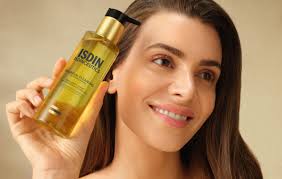
What Is Cleansing Oil and Who Should Use It?
It’s fascinating how cleansing oil transformed from a spa-only product to a daily skincare staple. Years ago, it was rare. Today, it’s essential for many people seeking healthy, balanced skin.
Cleansing oils have surged in popularity due to their ability to remove makeup, sunscreen, dirt, and impurities while being gentle and hydrating.
Unlike some cleansers, they don’t dry out or irritate the skin.
If you’re new to the concept, don’t worry. This guide will walk you through everything you need to know: what cleansing oils are, how they work, who should use them, and how to apply them properly.
What Exactly Is a Cleansing Oil?
Cleansing oil is a skincare product made with oil-based ingredients that bind to and dissolve oil-soluble impurities like sebum, makeup, and sunscreen without harming the skin’s moisture barrier.
Despite being made of oil, it doesn’t leave a greasy layer on the skin. The clever emulsifying agents in most formulas allow it to rinse cleanly with water without stripping the skin.
Many cleansing oils are designed to be used as the first step of a “double cleanse,” especially in the evening, though some people use them in the morning too for a fresh start.
Compared to traditional gel or foaming cleansers, which often contain harsh surfactants, cleansing oils help maintain hydration and prevent over-drying. They’re a gentle alternative for all skin types.
How to Properly Use a Cleansing Oil
Different brands may vary in their application instructions, but here is a general method for using most cleansing oils effectively for best results.
Begin by dispensing one to two pumps of oil into your clean, dry palms.
Rub your hands together to warm the oil, which helps it spread easily.
Gently massage the oil onto your dry face, covering all areas, especially where you wear makeup.
Focus on congested zones such as the T-zone or areas with blackheads or buildup.
Be extra gentle around your eyes, especially when removing mascara or eyeliner.
Add a small amount of warm water to your hands and continue massaging.
The oil will begin to emulsify and turn milky, helping lift debris from your skin.
Rinse thoroughly with lukewarm water, or use a soft cloth for a more thorough removal.
Follow up with a second cleanser to ensure all impurities are fully washed away.
Pat your face dry with a clean, soft towel. Never rub harshly.
It’s always a good idea to read the label and follow the specific instructions provided by the brand you’re using, as some oils may be better removed with a damp cloth.
How Does Cleansing Oil Actually Work?
Cleansing oils work through a simple principle in chemistry: “like dissolves like.” Oils are excellent solvents for other oils, so they help break down sebum and oil-based impurities.
When massaged onto dry skin, the oil binds with surface dirt, makeup, and dead skin cells. Once water is added, emulsifiers in the formula help lift these impurities away.
Contrary to common myths, cleansing oil does not clog pores. In fact, it can help prevent clogged pores by dissolving hardened sebum and buildup that lead to acne or blackheads.
This method also ensures that the skin’s natural moisture barrier remains intact. Unlike harsh cleansers, it does not strip essential oils, helping your skin feel balanced and hydrated.
Benefits of Using a Cleansing Oil
There are numerous benefits to adding a cleansing oil to your daily skincare routine, whether used alone or as the first step in a double cleansing method.
Cleansing oils effectively remove makeup, sunscreen, and pollutants without harsh rubbing.
They maintain the skin’s moisture and prevent tightness or dryness after cleansing.
Cleansing oils are rich in hydrating and nourishing ingredients like vitamin E and botanical oils.
They are ideal for removing waterproof makeup without irritating sensitive skin.
They dissolve hardened sebum in pores, helping to prevent blackheads and acne.
These oils leave the skin feeling soft, smooth, and supple after each use.
Their formulas often contain antioxidants that help fight free radicals and environmental stress.
They support a healthy skin barrier, which is essential for glowing, resilient skin.
Are Cleansing Oils Good for All Skin Types?
Yes, cleansing oils are generally suitable for all skin types, including oily, dry, sensitive, and combination skin. However, ingredient awareness is crucial for optimal results.
If you have oily or acne-prone skin, you might feel uneasy about applying more oil. But cleansing oils can actually help regulate sebum production and reduce breakouts.
Oily skin may benefit from lightweight formulas with ingredients like tea tree, grapeseed, or vitamin C. These help clear excess oil without causing further congestion or irritation.
For dry or mature skin, cleansing oils offer deep hydration. Ingredients like argan oil, rosehip, and jojoba nourish the skin, soothe dryness, and improve elasticity and radiance.
People with sensitive skin should choose fragrance-free options or formulas without potential irritants. Look for calming ingredients like chamomile, calendula, or oat oil.
Combination skin types can benefit too. Using a balanced formula can help normalize both dry and oily areas without causing imbalance in the skin’s natural oil production.
Choosing the Right Cleansing Oil for Your Skin
Not all cleansing oils are created equal. Some contain essential oils that may cause sensitivity, while others are formulated for specific concerns like dullness, breakouts, or aging.
Those with acne-prone skin should avoid oils like coconut or mineral oil, which can be comedogenic for some. Instead, opt for non-comedogenic oils like sunflower or hemp seed.
Dry skin types may appreciate thicker oils like avocado or olive oil, which provide extra nourishment. However, always do a patch test when trying new formulas.
Be cautious with DIY oils or those not meant for facial cleansing, such as baby oil or pure coconut oil. These can leave residues and lead to clogged pores or irritation over time.
When and Why to Double Cleanse
Double cleansing is a two-step process where you start with a cleansing oil to remove makeup and oil-based impurities. You then follow with a water-based cleanser for a deeper clean.
This technique is especially helpful at night when your skin has accumulated sweat, pollution, SPF, and makeup. It ensures your pores stay clear and your skin is ready for serums or moisturizers.
If you wear long-wear or waterproof makeup, double cleansing is highly recommended. Cleansing oil breaks down the makeup, and the second cleanser removes any leftover residue.
Even if you don’t wear makeup daily, double cleansing helps to clear sunscreen, environmental pollutants, and excess oil that builds up on the skin throughout the day.
Things to Keep in Mind
When using a cleansing oil, remember that a little goes a long way. Using too much can make rinsing harder and may leave a film if not emulsified properly with water.
If you wear heavy or matte makeup, you may need more effort or a second round of cleansing oil to ensure everything is fully removed. Follow with a gentle foaming cleanser afterward.
Do not expect cleansing oil to treat acne directly—it is a cleansing tool, not a treatment. However, by keeping pores clean and skin balanced, it can prevent some breakouts.
Cleansing oils should always be stored in a cool, dry place and used within their recommended shelf life to avoid spoilage or reduced effectiveness.
Final Thoughts
Cleansing oil is more than a trend—it’s a highly effective, skin-friendly method to cleanse without stripping the skin. It supports healthy skin, whether used alone or as part of a double cleanse.
With the right product and technique, cleansing oils can transform your skincare routine, leaving your skin refreshed, hydrated, and glowing. Give it a try and enjoy the results.


